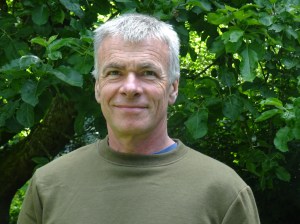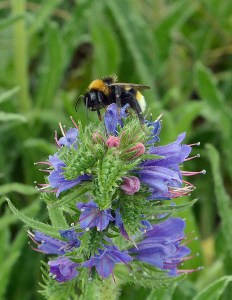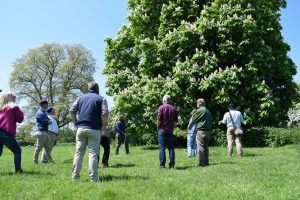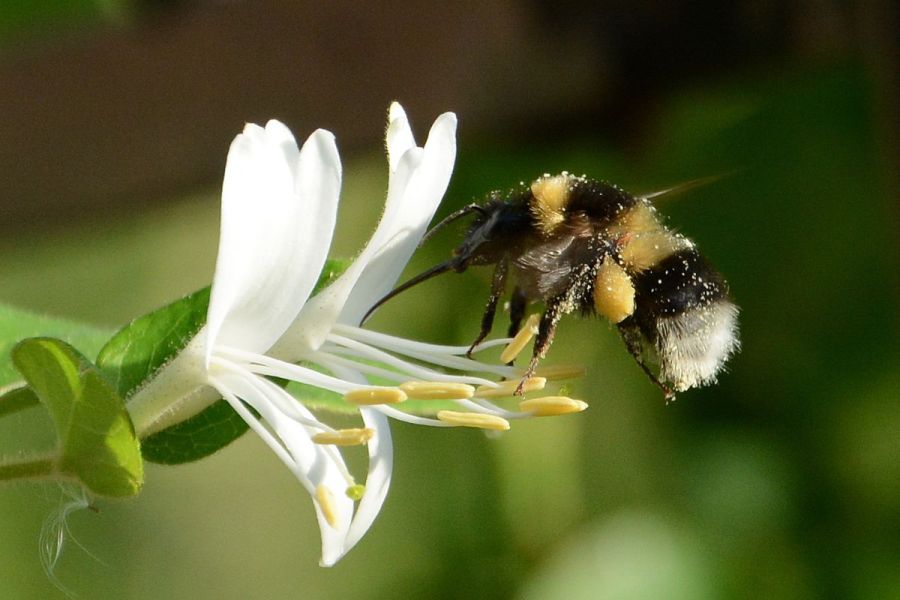Pollinators are key to so much in nature, but can encouraging specific species add value from a crop production perspective? CPM headed to the Allerton Project to find out.
“Permanent habitat is key to providing early food sources, such as willow and blackthorn.”
By Janine Adamson
With around 270 different bee species in Britain alone, identifying precisely which one has presented itself won’t always be easy. As well as diverse in appearance, wild bees are diverse in behaviour, something the Encouraging Pollinators open day at the Allerton Project explored.

Because 90% of bee species are solitary, their importance shouldn’t be played down, said John Holland.
The event focused on work conducted by the EU-funded Beespoke project, led by the Game and Wildlife Conservation Trust (GWCT). Opening the day was project coordinator Professor John Holland, who gave an introduction to the different types of pollinators. He explained that although many insects carry pollen, including hoverflies, butterflies, moths and beetles, because bees are ‘hairy’ they do a lot of the work.
And due to 90% of bee species being solitary (examples include the red mason bee, patchwork leaf-cutter bee and ashy mining bee), their importance in particular shouldn’t be played down. “Solitary bees can actually be more effective in a crop-based scenario than honeybees, partly due to their ability to remain active in cooler temperatures.
“There’s still much learning to be done on individual bee species, their host plant preferences and habitat choices, all of which we’re starting to investigate,” explained John.
So what are the key bee attributes? Honeybees are the only domesticated species with both bumblebees and solitary bees being classed as ‘wild’, and it’s these that were the focus of the event. Whereas the social species of bumblebees live in colonies and are either short or long-tongued, solitary bees mostly work alone, are often short-tongued and can be confused with other insects due to their small size.
Because they’re small, solitary bees have the ability to pollinate the plants which honeybees and bumblebees can’t, such as those in the Apiaceae family which includes carrots and parsnips. It’s also claimed that one red mason bee is equivalent to 120 worker honeybees in terms of pollination services. This is because solitary bees don’t have ‘pollen baskets’ on their hind legs, meaning each time they visit a flower, they lose more pollen than social bees.

Current wildflower mixes are mostly aimed at bumblebees, so improving the variety of plants would appeal to a greater range of bee species.
These are reasons why John believes solitary bees should be encouraged. “Research has shown the diversity of solitary bee species increases with plant diversity, so the more habitats we can provide, the better, including ponds and woodland areas,” he said. “Mining species also prefer barer ground for nesting as it’s easier to excavate into.”
In 2020, a study took place to evaluate the importance of insect pollination for specific crops. The research found it was highly variable, being most important for fruits and sunflowers, and less important for crops such as oilseed rape, which can be wind pollinated.
To discuss this further, ecologist Dr Lucy Capstick from the GWCT presented Beespoke’s research, which investigated how flower-rich field margins affect bean crop pollination. Although results varied greatly across the 13 field sites in the trial, Lucy said what became apparent was the difference in behaviour.
“Bees either rob a bean flower or forage. Foraging bees enter from the front and therefore pollinate when retrieving nectar. When they rob, they either chew a hole at the back of the flower or use one made by another bee to steal nectar without pollinating,” she said.
Lucy explained that certain species forage more than others and this could be due to tongue length. “Some flowers are shallow and easily accessible, but tubular flowers such as those produced by field beans are more suited to long-tongued bumblebees. These species are much lower in population, so the question is, how do we encourage them?”
Providing alternative nectar sources could be the answer to boosting foraging behaviour, so bees turn to beans for pollen only, although Lucy admitted this is an area requiring further research. However, much more is known about ‘what bees need’ from a general standpoint.
According to John, it’s all about diversity of floral resources. “Because of the difference in tongue length, offering a range of flower types will help to provide for a wider variety of species. For example, solitary bees require simple open flowers which can include weeds.

Many solitary bee species can be seen foraging from early spring, demonstrating the importance of providing resources early doors.
“Considering flower species which bloom throughout the year is also important to widen the window of resource. To that end, perennial habitats such as hedgerows and woodlands are great value because they flower at different points in the season,” he said.
Many solitary bee species can be seen foraging from early spring, with male hairy footed flower bees observed as early as February, demonstrating the importance of providing resources early doors.
For those already proactive in nurturing pollinators through engagement with the Countryside Stewardship Scheme (CSS), are certain options more bee-friendly than others? Although most contribute to some degree, John believes flower-rich areas are optimum.
“Wild bees forage up to 800m but will always visit the most abundant resource. What can be a problem is the amount of grass in seed mixes used for wildflower margins, which in the UK is up to 80%. Less grass or no grass, as used in Belgium and the Netherlands, and more flowers should improve flower establishment, thereby improving the appeal of the margins from a bee perspective.”
He also explained that current wildflower mixes are mostly aimed at bumblebees, so improving the variety of plants would appeal to a greater range of species, including solitary bees. And in taking action to improve the quality of pollinator habitats, John believes it could reduce the amount of land being taken out of agricultural production.
However, when it comes to making pollinator-centric changes, John acknowledged policy isn’t always helpful. “Agri-environment schemes would benefit from a level of flexibility to support farmers in encouraging pollinators. Weather, soil type, topography, available farm equipment and skill sets all vary and have an impact on what’s achievable.
“Free training would certainly be a recommendation to help farmers navigate the complexity of CSS options.”
Dr Saya Harvey manages an arable farm in Leicestershire and works as a consultant delivering Countryside Stewardship and Rural Development applications for landowners. As part of her role as training manager at the Allerton Project, she shared further information on CSS and the Sustainable Farming Incentive (SFI).
“New SFI options are due this summer, including the IPM standard where farmers will be paid to take BASIS-qualified advice to assess and produce an IPM plan, with extra payments for not using insecticides and for planting companion crops,” said Saya.
She explained there’s also the arable and horticultural land standard which pays farmers for establishing areas of nectar-rich flower mix or flower-rich grass margins, providing winter bird food and utilising buffer strips.
“This is encouraging and an ideal introduction for farmers wanting to dip their toe into Countryside Stewardship. However, for pollinators I believe permanent habitat is key to providing early food sources, such as willow and blackthorn,” she said.
In terms of wildflower seed mixes for margins, Lucy shared that research supported by the GWCT has already investigated bee preferences. The outcome of the work was that novel farmland seed blends attract a greater abundance of pollinating insects compared with standard mixes.

Providing alternative nectar sources for bees could be the answer to boosting foraging behaviour, said Lucy Capstick.
“Admittedly it can be very expensive to start creating your own seed mixes,” said Lucy. “The research concluded that a more viable approach is to purchase a readymade blend and top it up with bee-friendly species that suit your soil type and circumstances.”
But which flowers do wild bees actually prefer? Again, GWCT-supported work has explored this topic, surveying and ranking 45 wildflower species in order of attractiveness. The research found the top 14 species were visited by 37 out of the 40 wild bee species recorded, accounting for 99% of individual bee foraging sightings.
“The most popular wildflowers recorded included smooth hawksbeard, dandelion, meadow and hedgerow cranesbills, field bindweed and greater knapweed,” said Lucy. “Unfortunately, some of the favoured species are weeds such as charlock and perennial sow-thistle, so are unlikely to be taken up by farmers.”

Dead wood tree stacks are particularly appealing to leaf-cutter bees which dig into the rotting wood.
Following the formal presentations, delegates were then invited to partake in a two-hour farm walk exploring the Allerton Project site, led by ecologist John Szczur. The tour explored the many pollinator habitats across the Loddington Estate – from ponds and watercourses to semi-permanent pasture and arable buffer strips.
Among the stops on the walk was an area of low-input grassland, which John Szczur said is highly attractive to nesting solitary bees, despite not offering a pollen source. He explained that this habitat is ideal for locations with nearby mature trees, which address the grass’ lack of food supply.
John Szczur later explained the importance of water. “Yes, bees drink water, but species such as mason bees also require mud near to their nests to seal cells and protect their offspring. The added benefit of a watercourse is that wetland wildflowers bloom later in the year,” he said.
“If you can fence the area off then introduce livestock at the end of the season, this improves overall management and prevents one plant species from dominating.”

Delegates were invited to partake in a two-hour farm walk exploring the Allerton Project site, led by ecologist John Szczur.
John Szczur championed the small steps which famers are taking to encourage pollinators, such as building dead wood tree stacks. “This is an area that is constantly colonised by insects and is particularly appealing to leaf-cutter bees, which dig into the rotting wood,” he said, while pointing out an example at Allerton.
“It’s a simple habitat that can really benefit pollinators, although admittedly some might see it as untidy. I think that’s subjective, though.”
Towards the end of the walk, John Szczur warned of expecting too much from one habitat, a prime example being beetle banks. He said sowing flowers with pollinators in mind will in fact reduce the bank’s appropriateness for beetles. Instead, it should be managed in the conventional way while establishing alternative habitats elsewhere for bees.
Why the decline?
In the UK, there’s been a well-publicised decline in pollinator populations, including a 33% reduction in wild bee species. What may surprise is this decline isn’t a new thing, with extinction data spanning back to the 1800s, coinciding with the increase in farming and mechanisation.
John Holland said despite being a long-term trend, it’s actually the recent speed of decline that’s concerning. “It’s hard to identify the reason behind it, although studies of museum collections show little correlation with climate change and no phenological mismatch.
“Other studies have looked at the loss of host plants because some bee species are very particular in their preferences. It could also be due to a reduction in pollen from later flowering plants, which are a food source for overwintering queen bees. Overall, it’s attributed to habitat loss and land use change.”
Although climate change is unlikely to be the cause of the pollinator decline, it does have a considerable impact on agriculture as a whole. According to John, this means bees will take on an even more important role to withstand changes in climate.
“I’m not talking about just any bees, we require hardy, effective bees and lots of them. We’re often reminded to #savethebees, but this can be misinterpreted as talking about honeybees. These aren’t really the ones that require saving, it’s our wild bees.”
This article was taken from the latest issue of CPM. For more articles like this, subscribe here.
Sign up for Crop Production Magazine’s FREE e-newsletter here.




